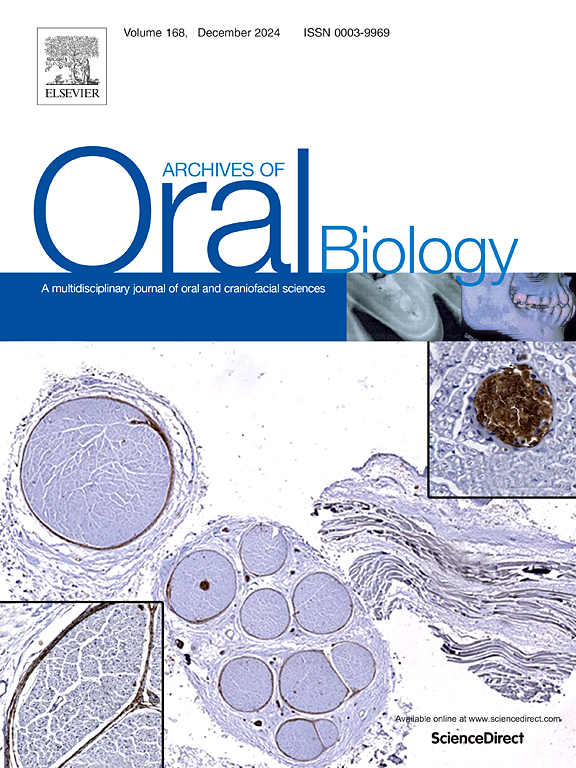BMP9对人根尖乳头干细胞中脂多糖诱导的基质金属蛋白酶的调控作用。
IF 2.2
4区 医学
Q2 DENTISTRY, ORAL SURGERY & MEDICINE
引用次数: 0
摘要
目的:研究基质金属蛋白酶(MMPs)家族成员在脂多糖(LPS)刺激下的表达变化及BMP9对MMPs的调控作用。设计:采用流式细胞术、茜素红染色、油红O染色和碱性磷酸酶染色对提取的人根尖乳头干细胞(hSCAPs)进行鉴定。采用实时定量PCR (RT-qPCR)和细胞计数试剂盒-8 (CCK-8)检测确定诱导hSCAPs炎症的合适LPS浓度。RT-qPCR检测lps刺激hSCAPs中MMP的表达。通过重组腺病毒在hSCAPs中过表达BMP9,并使用RT-qPCR、Western blotting和ELISA评估其对MMP调控的影响。所有实验均在体外进行。结果显示,LPS刺激后第3天和第5天,hSCAPs中MMP-1、MMP-2、MMP-3、MMP-8、MMP-9、MMP-10、MMP-12和MMP-13的表达显著上调。LPS诱导后第7天,hSCAPs中MMP-3、MMP-8、MMP-9和MMP-13的表达量显著升高。当BMP9在hSCAPs中过表达时,升高的MMPs受到不同程度的抑制。结论:在lps诱导的炎症环境中,hSCAP中某些MMPs升高,其中以MMP-13最为显著。BMP9过表达可显著抑制MMPs的升高,提示BMP9可能为根尖周炎的治疗提供新的见解和靶点。本文章由计算机程序翻译,如有差异,请以英文原文为准。
The regulatory role of BMP9 on lipopolysaccharide-induced matrix metalloproteinases in human stem cells from the apical papilla
Objective
The aim of this study was to investigate changes in the expression of members of the matrix metalloproteinases (MMPs) family in response to lipopolysaccharide (LPS) stimulation and to investigate the regulatory effects of BMP9 on MMPs.
Design
The extracted human stem cells from the apical papilla (hSCAPs) were identified by flow cytometry, Alizarin Red staining, Oil Red O staining, and alkaline phosphatase staining. The appropriate LPS concentration for inducing inflammation in hSCAPs was determined using real-time quantitative PCR (RT-qPCR) and Cell Counting Kit-8 (CCK-8) assays. MMP expression in LPS-stimulated hSCAPs was evaluated by RT-qPCR. BMP9 was overexpressed in hSCAPs via recombinant adenovirus, and its effects on MMP regulation were assessed using RT-qPCR, Western blotting, and ELISA. All experiments were conducted in vitro. Data were analyzed by one-way ANOVA followed by Tukey’s post-hoc comparison, with p < 0.05 considered significant.
Results
The results showed that on the 3rd and 5th day after LPS stimulation, the expression of MMP-1, MMP-2, MMP-3, MMP-8, MMP-9, MMP-10, MMP-12, and MMP-13 in hSCAPs was significantly upregulated. On the 7th day after LPS induction, the expression of MMP-3, MMP-8, MMP-9 and MMP-13 in hSCAPs was significantly increased. When BMP9 was overexpressed in hSCAPs, the elevated MMPs were inhibited to varying degrees.
Conclusions
In the LPS-induced inflammatory environment, certain MMPs are elevated in hSCAP, with MMP-13 being the most significant. Overexpression of BMP9 can significantly inhibit elevated MMPs, suggesting that BMP9 may provide new insights and targets for the treatment of periapical periodontitis.
求助全文
通过发布文献求助,成功后即可免费获取论文全文。
去求助
来源期刊

Archives of oral biology
医学-牙科与口腔外科
CiteScore
5.10
自引率
3.30%
发文量
177
审稿时长
26 days
期刊介绍:
Archives of Oral Biology is an international journal which aims to publish papers of the highest scientific quality in the oral and craniofacial sciences. The journal is particularly interested in research which advances knowledge in the mechanisms of craniofacial development and disease, including:
Cell and molecular biology
Molecular genetics
Immunology
Pathogenesis
Cellular microbiology
Embryology
Syndromology
Forensic dentistry
 求助内容:
求助内容: 应助结果提醒方式:
应助结果提醒方式:


